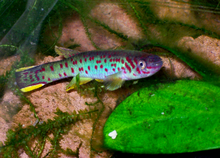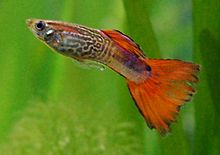- Cyprinodontiformes
-
Cyprinodontiformes
Temporal range: Oligocene–Recent
Mummichog (Fundulus heteroclitus heteroclitus)
Female (top right) and two malesScientific classification Kingdom: Animalia Phylum: Chordata Superclass: Osteichthyes Class: Actinopterygii Subclass: Neopterygii Infraclass: Teleostei Superorder: Acanthopterygii Order: Cyprinodontiformes
Berg, 1940Suborders Aplocheiloidei
CyprinodontoideiSynonyms Microcyprini Regan, 1909
The Cyprinodontiformes (
 /ˌsaɪprɨnɵˌdɒntɨˈfɔrmiːz/) is an order of ray-finned fish, comprising mostly small, fresh-water fish. Many popular aquarium fish, such as killifish and live-bearers, are included. They are closely related to the Atheriniformes and are occasionally included with them. A colloquial term for the order as a whole is toothcarps, though they are not actually close relatives of the true carps – the latter belong to the superorder Ostariophysi, while the toothcarps are Acanthopterygii.
/ˌsaɪprɨnɵˌdɒntɨˈfɔrmiːz/) is an order of ray-finned fish, comprising mostly small, fresh-water fish. Many popular aquarium fish, such as killifish and live-bearers, are included. They are closely related to the Atheriniformes and are occasionally included with them. A colloquial term for the order as a whole is toothcarps, though they are not actually close relatives of the true carps – the latter belong to the superorder Ostariophysi, while the toothcarps are Acanthopterygii.The families of Cyprinodontiformes can be divided into three groups: viviparous and ovoviviparous (all species give live birth), and oviparous (all species egg-laying). The live-bearing groups differ in whether the young are carried to term within (ovoviviparous) or without (viviparous) an enclosing eggshell. Phylogenetically however, one of the two suborders – the Aplocheiloidei – contains oviparous species exclusively, as do two of the four superfamilies of the other suborder (the Cyprinodontoidea and Valencioidea of the Cyprinodontoidei). Vivipary and ovovivipary have evolved independently from oviparous ancestors, the latter possibly twice.
Description
 Fundulopanchax scheeli, a killifish of the Aplocheilidae.
Fundulopanchax scheeli, a killifish of the Aplocheilidae.
Members of this order are notable for inhabiting harsh environments, such as saline or very warm waters, water of poor quality, or isolated situations where no other types of fish occur. They are typically omnivores, and often live near the surface, where the oxygen-rich water compensates for environmental disadvantages.
They are small to medium fish, with small mouths, large eyes, a single dorsal fin, and a rounded caudal fin. The largest species is the cuatro ojos (Anableps dowi), which measures 34 centimetres (13 in)[1] in length, while the smallest, the least killifish (Heterandia formosa), is just 8 millimetres (0.31 in) long as an adult.[2]
Systematics
ORDER CYPRINODONTIFORMES
- Suborder Aplocheiloidei (all oviparous)
- Family Aplocheilidae – South Asian and Malagasy killifishes (also the West Africa Pseudepiplatys annulatus)
- Family Nothobranchiidae – African killifishes, formerly in Aplocheilidae
- Family Rivulidae – rivulids or South American killifishes
- Suborder Cyprinodontoidei
- Superfamily Funduloidea (oviparous)
- Family Profundulidae – Central American killifishes (oviparous)
- Family Goodeidae – splitfins (viviparous)
- Family Fundulidae – topminnows and North American killifishes (oviparous)
- Superfamily Valencioidea (oviparous)
- Family Valenciidae – Mediterranean killifishes
- Superfamily Cyprinodontoidea (oviparous)
- Family Cyprinodontidae – pupfishes
- Superfamily Poecilioidea
- Family Anablepidae – four-eyed fishes and relatives (ovoviviparous)
- Family Poeciliidae – livebearers and relatives (some oviparous, some ovoviviparous)
- Superfamily Funduloidea (oviparous)
References
- ^ http://www.discoverlife.org/mp/20q?search=Anableps+dowi&flags=col3:&res=320
- ^ Parenti, Lynne R. (1998). Paxton, J.R. & Eschmeyer, W.N.. ed. Encyclopedia of Fishes. San Diego: Academic Press. pp. 148–151. ISBN 0-12-547665-5.
Froese, Rainer, and Daniel Pauly, eds. (2007). "Cyprinodontiformes" in FishBase. August 2007 version.
Kingdom Animalia · Phylum Chordata · Subphylum Vertebrata · Infraphylum Gnathostomata · Superclass OsteichthyesChondrostei Neopterygii Lepisosteiformes · Amiiformes · Osteoglossiformes · Hiodontiformes · Elopiformes · Albuliformes · Notacanthiformes · Anguilliformes · Saccopharyngiformes · Clupeiformes · Gonorynchiformes · Cypriniformes · Characiformes · Gymnotiformes · Siluriformes · Salmoniformes · Esociformes · Osmeriformes · Argentiniformes · Ateleopodiformes · Stomiiformes · Aulopiformes · Myctophiformes · Lampriformes · Polymixiiformes · Percopsiformes · Batrachoidiformes · Lophiiformes · Gadiformes · Ophidiiformes · Mugiliformes · Atheriniformes · Beloniformes · Cetomimiformes · Cyprinodontiformes · Stephanoberyciformes · Beryciformes · Zeiformes · Gasterosteiformes · Syngnathiformes · Synbranchiformes · Tetraodontiformes · Pleuronectiformes · Scorpaeniformes · Perciformes
This Cyprinodontiformes article is a stub. You can help Wikipedia by expanding it. - Suborder Aplocheiloidei (all oviparous)

